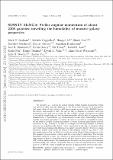SDSS-IV MaNGA : stellar angular momentum of about 2300 galaxies: unveiling the bimodality of massive galaxy properties
Abstract
We measure λRe, a proxy for galaxy specific stellar angular momentum within one effective radius, and the ellipticity, ϵ, for about 2300 galaxies of all morphological types observed with integral field spectroscopy as part of the MaNGA survey, the largest such sample to date. We use the (λRe,ϵ) diagram to separate early-type galaxies into fast and slow rotators. We also visually classify each galaxy according to its optical morphology and two-dimensional stellar velocity field. Comparing these classifications to quantitative λRe measurements reveals tight relationships between angular momentum and galaxy structure. In order to account for atmospheric seeing, we use realistic models of galaxy kinematics to derive a general approximate analytic correction for λRe. Thanks to the size of the sample and the large number of massive galaxies, we unambiguously detect a clear bimodality in the (λRe,ϵ) diagram which may result from fundamental differences in galaxy assembly history. There is a sharp secondary density peak inside the region of the diagram with low λRe and ϵ < 0.4, previously suggested as the definition for slow rotators. Most of these galaxies are visually classified as non-regular rotators and have high velocity dispersion. The intrinsic bimodality must be stronger, as it tends to be smoothed by noise and inclination. The large sample of slow rotators allows us for the first time to unveil a secondary peak at +/-90 degrees in their distribution of the misalignments between the photometric and kinematic position angles. We confirm that genuine slow rotators start appearing above a stellar mass of 2 x 1011 M⊙ where a significant number of high-mass fast rotators also exist.
Citation
Graham , M T , Cappellari , M , Li , H , Mao , S , Bershady , M , Bizyaev , D , Brinkmann , J , Brownstein , J R , Bundy , K , Drory , N , Law , D R , Pan , K , Thomas , D , Wake , D A , Weijmans , A-M , Westfall , K B & Yan , R 2018 , ' SDSS-IV MaNGA : stellar angular momentum of about 2300 galaxies: unveiling the bimodality of massive galaxy properties ' , Monthly Notices of the Royal Astronomical Society , vol. 477 , no. 4 , pp. 4711-4737 . https://doi.org/10.1093/mnras/sty504
Publication
Monthly Notices of the Royal Astronomical Society
Status
Peer reviewed
ISSN
0035-8711Type
Journal article
Description
AW acknowledges support of a Leverhulme Trust Early Career Fellowship.Collections
Items in the St Andrews Research Repository are protected by copyright, with all rights reserved, unless otherwise indicated.
Related items
Showing items related by title, author, creator and subject.
-
SDSS-IV MaNGA: How the stellar populations of passive central galaxies depend on stellar and halo mass
Oyarzún, Grecco A.; Bundy, Kevin; Westfall, Kyle B.; Tinker, Jeremy L.; Belfiore, Francesco; Argudo-Fernández, Maria; Zheng, Zheng; Conroy, Charlie; Masters, Karen L.; Wake, David; Law, David R.; McDermid, Richard M.; Aragón-Salamanca, Alfonso; Parikh, Taniya; Yan, Renbin; Bershady, Matthew; Sánchez, Sebastián F.; Andrews, Brett H.; Fernández-Trincado, José G.; Lane, Richard R.; Bizyaev, D.; Boardman, Nicholas Fraser; Lacerna, Ivan; Brownstein, J. R.; Drory, Niv; Zhang, Kai (2022-07-06) - Journal articleWe analyze spatially resolved and co-added SDSS-IV MaNGA spectra with signal-to-noise ratio ∼100 from 2200 passive central galaxies (z ∼ 0.05) to understand how central galaxy assembly depends on stellar mass (M*) and halo ... -
Secular-and merger-built bulges in barred galaxies
Mendez Abreu, Jairo; Debattista, V. P.; Corsini, E. M.; Aguerri, J. A. L. (2014-12) - Journal articleContext. Historically, galaxy bulges were thought to be single-component objects at the center of galaxies. However, this picture is now questioned since different bulge types with different formation paths, namely classical ... -
Galaxy And Mass Assembly (GAMA) : galaxy close pairs, mergers and the future fate of stellar mass
Robotham, A. S. G.; Driver, S. P.; Davies, L. J. M.; Hopkins, A. M.; Baldry, I. K.; Agius, N. K.; Bauer, A. E.; Bland-Hawthorn, J.; Brough, S.; Brown, M. J. I.; Cluver, M.; De Propris, R.; Drinkwater, M. J.; Holwerda, B. W.; Kelvin, L. S.; Lara-Lopez, M. A.; Liske, J.; Lopez-Sanchez, A. R.; Loveday, J.; Mahajan, S.; McNaught-Roberts, T.; Moffett, A.; Norberg, P.; Obreschkow, D.; Owers, M. S.; Penny, S. J.; Pimbblet, K.; Prescott, M.; Taylor, E. N.; van Kampen, E.; Wilkins, S. M. (2014-11-11) - Journal articleWe use a highly complete subset of the Galaxy And Mass Assembly II (GAMA-II) redshift sample to fully describe the stellar mass dependence of close pairs and mergers between 10(8) and 10(12)M(circle dot). Using the analytic ...

